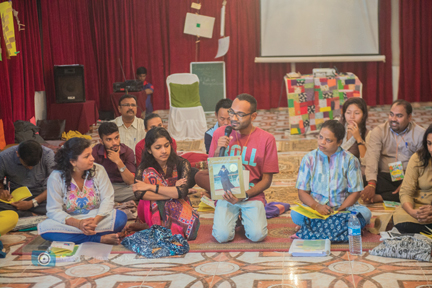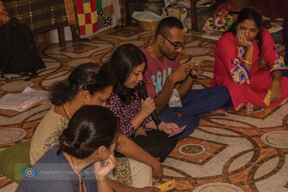Neeraj Naidu
As a child, I was always excited to travel by train because it provided me the only opportunity to buy books that were not prescribed by the school. During the journey, when the train stopped at a railway station, among the babel of sounds that rushed inside, I liked one particularly. “Comics! Comics!”
A person holding nearly 30 small comic books (more in a large jhola) would stop at the window when called loudly and present the entire collection to us for browsing. My sister and I would start looking at the book covers, reading the titles and flipping through the pages. Both of us knew that we had very little time and the train would soon depart, so we browsed at super-speed to choose/buy the comic books. It was one of the first instances of book-browsing and generously offered not by a teacher or a librarian but by a comic book seller at the railway station.
Browsing
When I assisted the Bookworm* team for six days for the ‘Library Educator’s Course# 2021-22, I was stimulated to hear a number of field-project presentations by the participants, exploring the idea of browsing in a children’s library. It reminded me of my own browsing history and I began to reflect on the need of the very act of browsing – touching, seeing, smelling and looking at books to pick one (or more). It’s a fascinating act to both observe and do because no one knows what makes a person pick one book from many. And apart from this mysterious influence, there are some informed ways like reading the blurb at the back of the book, etc., that people use to choose. The act of both free-browsing and informed-browsing is a crucial part of any children’s library. Listening to the presentations refreshed my approach towards browsing, an act that bridges the space between the book and the reader.

L.E.C.
The Library Educator’s Course is a unique course that awakens one to see children’s libraries as a site of education by building a deep understanding of children’s literature and libraries and by further exploring the radical act of reading.
While working as a school teacher and being a reader of all kinds of books, it was a natural decision to introduce my students to the world of books and, hopefully, make them fall in love with them. But my own pocket-sized exposure and knowledge constricted my students journey in becoming readers. It was only when I participated in the ‘Library educator’s course’ in 2017, that I was introduced to the enormity and scope of children’s literature and how children’s libraries could be democratic and safe spaces to fearlessly read, engage with new ideas and dialogue about issues that both disturb and comfort. Post LEC, my classroom brimmed with both children’s books and children with books in their hands. I started a classroom library and along with the children, ran it till they passed out. In all those years, most students read hundreds of books and talked a great deal about them with me and others.
The course did not end for me in 2017. Instead, I became a part of a community of lovely library people. I went back as an alumni to the course in 2018 to share about my field-project. I attended a new session (by Thejaswi Shivanand) that wasn’t there in ’17. In it, broad discussions happened on whether ‘values’ should be taught or not or even talked about while engaging with children’s literature in the classroom and how, sometimes, literature is deliberately constructed to forcefully inculcate certain values in children. I was particularly hooked to this session because I see, in my daily work in Sukma (a district in Chhattisgarh), the values and practices of politically powerful Hindu communities being imposed on children of non-Hindu indigenous/Adivasi communities in schools through indoctrination, sanskritization and textbook teaching.
In 2020, during the pandemic, when the course went online (yes! Bookworm put in massive efforts to take the course online), I shared my work again with the participants on Zoom. I was astonished to see the online library setup which almost looked like physical shelves. I was, however, immensely sad about the course not being held offline because that’s how I experienced the course and where I got to hold hundreds of new books in my hands. The space that I, my fellow participants and the faculty created at the time of our course brought us close and most of us are still in touch and even work together on projects. It brings joy to know that the community is just a WhatsApp text away.
In 2022, when Bookworm asked if any alumni wished to help in the course, I instantly volunteered. There is never a dull moment in the contact-period when participants come together physically to attend sessions for a week because the pedagogies involved are diverse and multimodal. People read, move, jump, dance, dialogue, watch, perform, stitch and laugh a lot. But one of the most beautiful parts of this period, for me, has always been the displays.
Display
Displays lie stationary but shake people like the break-dance ride at a fair. A particular theme is woven around the displays thought through by the display-maker (or the library educator) and presented. The books that express the theme are chosen mindfully. A material culture is built around the books that supplement the theme and sometimes inspire curiosity. Games and activities are also seamlessly added to engage people. Every time you engage with the display, you find something new. Like a sea-shore, where you find a new wave every time you put your feet in the same water.
This time a powerful display (by Sujata and team) on the theme of ‘Caste’ caught my attention and demanded intense engagement. Written on a sheet in dark red ink, “Are we a casteless society?” glared at me. I interacted with the display everyday and also picked up a new book to read from the display table. I played a game. I saw what people added to the display. My engagement with the theme increased and I started talking about it with people. But as I reflected, I wondered if displays are also about absences, what’s not there? Why a certain book which seems to have a connection with the theme is not chosen? What has been the curation process? Does the display-maker act on individual taste or does he/she follow a particular procedure of curation? If I set-up a display, how will I curate?
The books that I’ve picked up and read from the display table were so beautiful and yet very unsettling that I kept thinking, as a reader about the theme, and as a library educator about the design of thematic displays that silently makes a deafening sound.

Poetry
In a session facilitated by Radha Gopalan, I chanced on a section of Chandramohan Sathyanathan’s ‘Beef Poem’ and heard how it evoked different feelings in each one of us in a small group. Jane Sahi’s session on working with poetry soothed and inspired me and brought my attention to the place of poetry, which often takes a back seat, in a library space. Call it my bias but I believe the abstractness and, sometimes, the naked lucidity of the language of poetry demands a special place in the library. In the past many years, I have realized that poetry-books, have always been marginalized among the storybooks in my classroom library. I tried hard but could not find the books. Especially rare was the kind of poetry my students in their teenage years wanted to read. So, we ourselves wrote and read poems in the class. But it still restricted us in our journey to read poems.
In the space where the sessions were held in the LEC, Bookworm had setup an entire shelf on poetry including poetry for children, teens, adults and everybody else. I had an eye on that shelf and got really happy when anybody picked up a book from that shelf. One day I will make a library where there will be as many poetrybooks as storybooks.
People
It’s been five years as part of the LEC community and every time I meet with these people, who are trying to take open libraries to every dot on the map of India, allow access to books to every child and spread the love of reading to every heart, the idea of a library educator being central to libraries is reinforced. Breaking the stereotype of a bookish person as a caretaker of books and a lackadaisical librarian, a library educator works with both books and people in a creative, active and critical way. The centrality of this person brings, in Spiderman’s uncle’s words, great power and thus great responsibility. Without this one (sometimes many) person, the library educator, a library is no more than a quiet mortuary. Shhhh!
As a library educator
When I hear about the recent violent events triggered by voices of hyper-nationalism and religious-radicalization, it becomes necessary, especially for children who are at risk, to have spaces of dialogue to understand differences and diversity. The children need to have books to read and find not just themselves but also others around them as equals, to interact with texts that are difficult because it might illustrate the pain of people living faraway and sometimes of people living so close that it reveals their own privileges. Where else can this happen other than in a library? And not to forget, all of us need a comforting library space to read and smile and laugh (and strictly not stay silent), just like I laughed like a hyena when I read the book, I need a new butt written by Dawn McMillan and illustrated by Ross Kinnaird. It was my last day at LEC and the book was surprisingly brought to me by super-library-educator, Sujata. She didn’t forget that I’d asked for the book. To a library educator, every reader matters.
Each time I go to LEC, certain ideas are reconsolidated, practices reconstructed and understanding upgraded. But above all that, the love and kindness of people I receive reaffirms my own journey of making library spaces that exude both, love for books and people. This is why I love going back to the Library Educator’s Course community.
*Bookworm works with children, youth, adults and the larger community in diverse and varied contexts with a vision to inspire and develop a love for reading as a way of life, nurturing humane engagement in every girl, boy and others. (Source: Bookworm)
#The Library Educator’s Course is a Professional Development Certificate course developed by Parag (an initiative of Tata Trusts) and being offered in English by Bookworm Trust, Goa since 2017. The course is open to all educators and intended for teachers, school librarians, development sector professionals, literacy educators and language experts. The course is best suited for individuals working with children and books and interested in developing library practices and learning. (Source: Bookworm)
Some of the books on the display that I engaged with are:
• ‘Mirchika Chura’ and ‘Pongal’ by Bama and illustrated by Karen Haydock
• ‘Tataki Wins Again and Braveheart Badeyya’ by Gogu Shyamala and illustrated by Puja Vaish and Rashmi Mala
• ‘Mother’ by KanchaIlaiah Shepherd and illustrated by Lokesh Khodke and Shefalee Jain
• ‘Under the Neem Tree’ by P. Anuradha and illustrated by A.V. Ilango
• ‘The Women I Could Be’ by SangitaJogi
• ‘The New Potter’ by Maheen Mirza and illustrated by Sagar Kolwankar
• ‘Going to School Alone’ by Simran Uikey and illustrated by Kruttika Susarla
The author works with children in and out of school spaces and has a deep interest in children’s literature, poetry and arts. He lives in Sukma and can be reached atirockmad@gmail.com.
